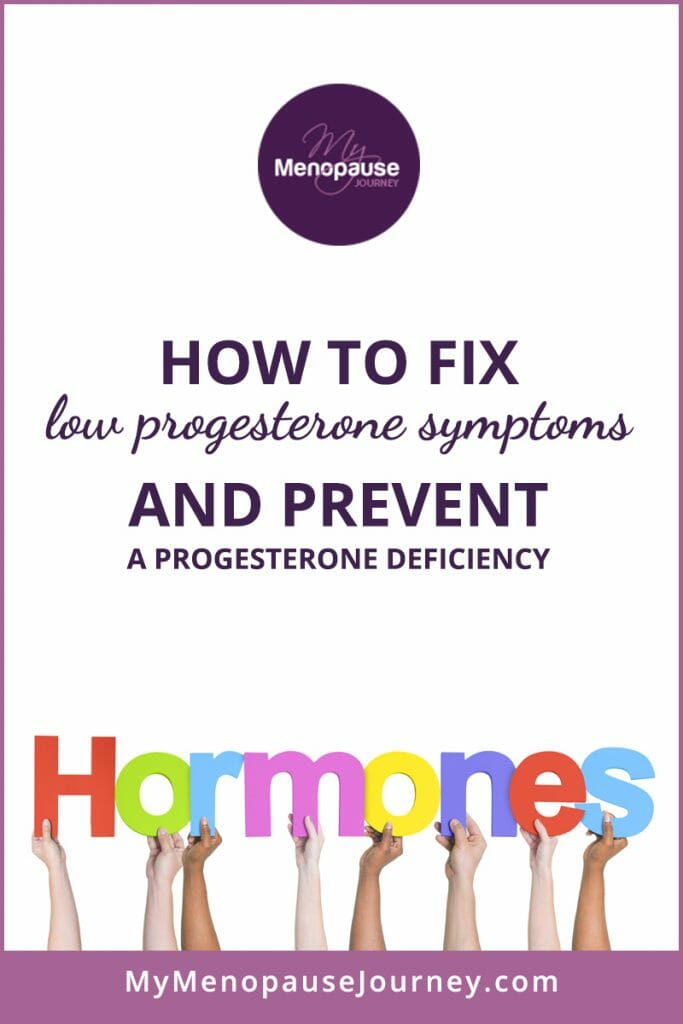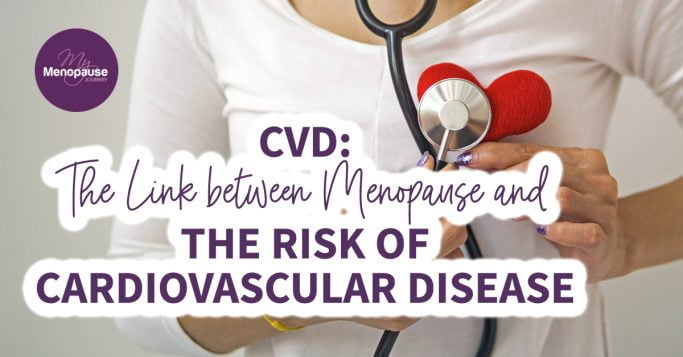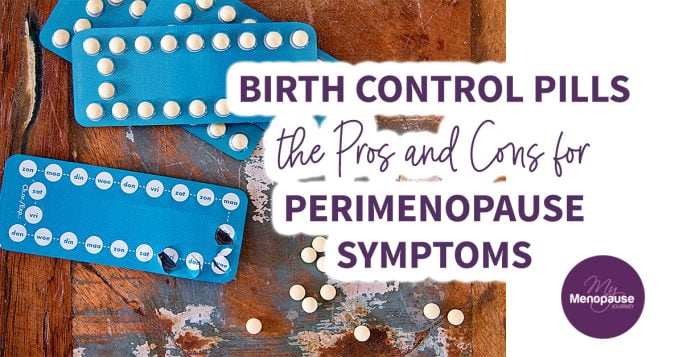Estrogen is the queen of all hormones. But hey, we also have other super essential whoppers like progesterone and testosterone. They don’t get all the attention, but they also play an important role in menopause, especially progesterone. Low progesterone symptoms in menopause are common and, in this article, we are going to know why!
Progesterone has such a profound effect on our health. Like estrogen, progesterone has many partner organs in the body. When progesterone’s balance gets tipped off, our body creates a ripple effect, and we can feel the sting through our symptoms.
If you haven’t paid attention to this powerhouse hormone before, now is a good time to give it some love. We can do that by finding out why low progesterone symptoms in menopause occur and tips for maintaining your progesterone levels.


What is progesterone?
Progesterone isn’t just a female hormone – it’s so much more! It’s vital to our health and it can even be a game-changer in our menopause journey.
Behind its positive effects on our body, this hormone’s name is even more interesting! “Pro” means to support, and “Gest” means gestation. This is progesterone’s main role in our body, to allow us to nurture and carry babies in the womb and bring them to maturity.
A large amount of our progesterone comes from our ovary’s corpus luteum, and small amounts are created in our adrenal glands. Our placenta also secretes this hormone during pregnancy to make sure that the baby holds tightly until full term.
You might wonder, aside from making pregnancy possible, is progesterone a big deal in our body? Absolutely! It performs other enormous tasks on a daily basis, including:
- Maintaining our menstrual cycles for regular monthly periods.
- Keeping our reproductive organs healthy to better fight infections.
- Firing up our metabolism to produce energy and prevent weight gain.
- Strengthening our bones and preventing osteoporosis.
- Regulating blood sugar levels to reduce the risk of diabetes.
- Boosting our libido to prepare the body for intimacy
- Stimulating the release of our happy hormones for a better mood.
Progesterone’s amazing qualities don’t end here! The hormone can even transform itself to estrogen and testosterone if needed. This is one of the main reasons why it’s super important during menopause.
But do you know progesterone’s best role yet? It is the ability to tame the wild side of estrogen. Estrogen undeniably does our body good, but when we let the hormone do whatever it wants, it’s going to go on an unstoppable rampage (like it does during menopause) – and we won’t fall short of feeling its stingy symptoms.
The Natural Progesterone Information Service explains that because estrogen and progesterone have opposing effects, it’s important to maintain the balance of these two hormones if we want to preserve peace in our body.
What happens to progesterone levels during menopause?
Like us, progesterone also has its fair share of ups and downs during menopause. Progesterone is even the first hormone that our body annoys way before estrogen. We’ll talk about this more later, but first, let’s find out what happens to progesterone as we enter our menopausal transition.
Menopause happens earlier than we know. It happens to some women in their late 30s or early 40s and this stage of menopause is called perimenopause. In perimenopause, many of us still have our monthly periods and are still capable of getting pregnant.
Two weeks before we have our periods, estrogen goes up in preparation for ovulation. Progesterone is also present in minimal amounts. But in the last two weeks of our monthly cycle, progesterone balances the effects of estrogen so menstruation stops. This is normally how it goes.
But all this can change near the end of our perimenopausal years. Our ovaries will slowly lose their strength to produce estrogen, so more often, we experience anovulation. Ovulation is necessary for the production of progesterone. Besides, as we age, we also lose our ability to get pregnant because of our aging uterus, fallopian tubes and more! So progesterone goes on a natural slump during perimenopause.
And this is where our discomforts begin…
Our ovaries will start to prioritize which hormone to produce first: estrogen or progesterone? In the end, it chooses our estrogen because it has more receptors throughout our body. So, estrogen doesn’t have it too tough, and its bag becomes fuller than progesterone. This disturbance in the estrogen to progesterone ratio is called Estrogen Dominance (ED).
With no progesterone to keep estrogen effects at bay, our emotions go up and down. We feel like a totally different person. For example, serotonin and gamma-Aminobutyric acid (GABA) are good hormones that can make us feel calm, but when estrogen is a little too high, these hormones are over-stimulated and we’ll feel anxious, sad or moody.
Together with perimenopause, low progesterone levels and stress (which lowers progesterone even more), we feel all kinds of low progesterone symptoms in menopause. Here are some of them:
- Severe menstrual cramps. High estrogen pumps up our uterine contractions, so we’ll feel a lot of pain even before we have our periods (which are irregular by the way).
- Mid menstrual cycle spotting. Progesterone helps tell the body when to start menstruating but with low levels, it may confuse our reproductive system which leads to spotting in some women.
- Foggy thinking. Progesterone maintains the health of our mitochondria (the main energy source of the brain) so lack of the hormone may cause brain fog.
- Lack of energy for sex. Together with testosterone, progesterone activates our body for intimacy by increasing blood supply in our reproductive organs.
- Severe skin issues (acne, cracked and chapped skin). The hormone progesterone is one of the key players in the production of collagen and elastin which maintains skin health.
- Cravings. Ever heard about the progesterone-fueled snack attacks? Well, it’s a true phenomenon! Low progesterone increases our cravings, so we try to comfort ourselves by grabbing some sweets and drinking a glass of wine.
- Swelling. One of the many low progesterone symptoms is bloating. Progesterone is our body’s natural diuretic so without it, we are not able to get rid of excess fluids.
- Weight gain. Progesterone helps us maintain a healthy weight by stimulating our thyroid glands to produce hormones which will boost metabolism and burn fats faster. Low progesterone levels can make our metabolism sluggish and we will experience greater fat buildup.
- Breast pain. Our breasts are very sensitive to estrogen and with no progesterone to combat its action, it over-stimulates our breast tissues, causing pain.
- Achy joints and muscles. Estrogen stimulates our osteoclasts to build bones and our growth hormone to build muscles. But when estrogen is high it hyperactivates this function leading to bone and muscle tension.
There are also women who experience different low progesterone symptoms in menopause than what we’ve rounded up. Discover other low progesterone symptoms in menopause in Dr. Jockers’ article about estrogen dominance.
Dr. Berg also has a great video about estrogen dominance and how the menstrual cycles work [16:56]:
Why Low Progesterone Symptoms Occur
- Chronic stress. If we’re stressed, our body spurts out a lot of cortisol. This hormone will then communicate with the ovaries and adrenal glands to slow down its secretion of progesterone. As if it isn’t enough, cortisol will also tell our organs not to receive progesterone.
- Insulin resistance. When our cells don’t receive insulin, our sugar levels will rise, and this will affect the absorption of our progesterone too.
- Poor lifestyle. Without regular exercise, our glands can get tired too (this goes for other hormones as well) and they stay dormant. As a result, progesterone production declines. The processed and fast foods we eat have xenoestrogens and toxins which can increase estrogen.
- Polycystic Ovarian Syndrome (PCOS). When we have PCOS, our body will find it hard to ovulate. Ovulation is needed to stimulate the secretion of our progesterone and without this trigger, our progesterone levels will go down. Also, when our brain sees that we lack progesterone, it ups the production of other hormones, increasing estrogen which further suppresses progesterone.
- Hypothyroidism. Our thyroid glands are helpful in ovulation (which triggers progesterone production). In hypothyroidism our thyroid hormones especially Triiodothyronine (T3) goes low. T3 is the main hormone for creating progesterone.
- Birth control pills. These tiny pills stop ovulation and they also increase estrogen – the two recipes for progesterone disaster.
8 Ways to Balance Progesterone Levels
- De-stress! As I’ve mentioned before, stress is one factor that can lower our progesterone so learn to slow down. Prioritize, delegate and get rid of things that are not worth your time. Relax with yoga, meditation and even simple deep breathing.
- Opt for organic protein. If you’re feeling anxious or sad, tryptophan (an amino acid) may somehow ease how you’re feeling because it can balance your serotonin levels. Foods rich in this amino acid include hemp seeds, chia, quinoa, spirulina and a lot of nuts and seeds. More of plant-based proteins in Dr. Axe’s article. If you want to eat meat, grass-fed is the best way to go. Tryptophan can also be taken as a supplement as 5-HTP. Vitamins B6 and D, magnesium and zinc are also good in balancing serotonin levels.
- Make adaptogenic herbs part of your diet. Adaptogens are balancing compounds found in herbs like Chasteberry/Vitex, Rosemary, Licorice, Ginseng, Ashwagandha Milk Thistle and Holy Basil [links]. You can have them together with your meals or you may do a homemade remedy out from them, just like this adrenal support tea which is filled with adaptogenic herbs!
- Avoid using plastic things. Xenoestrogens are your progesterone’s nemesis, because it messes up your hormone balance big time by suppressing progesterone. Guess what? Plastic products have a lot of xenoestrogens plus they also have toxins and free radicals.
- Eat fiber-rich foods. Flush out xenoestrogen by eating high fiber foods like cruciferous veggies, leafy greens, beans, berries and all kinds of citrus fruits.
- Keep your weight under control. The more extra fats we have, the more estrogen we produce. This is because testosterone automatically converts excess fats to estrogen. It will help if we keep our weight within normal by doing regular exercise, eating healthier and sleeping better. You may also want to find out what’s causing your weight gain, because it can be due to thyroid issues.
- Try acupuncture. It’s one of the most effective ways to relieve muscle tension, increase blood circulation and boost energy levels.
- Consider using progesterone creams. Experts suggest using 20mm/gr twice a day for progesterone creams. The recommended use is 16 to 28 days after your ovulation.
Dr. Axe explains that natural progesterone cream may be the answer to our hormonal imbalances and the key to feeling better.
The amount of progesterone cream given is different from woman to woman. Doctors usually base doses on a woman’s personal needs. Results may also vary greatly, with some saying they felt changes as fast as day one and others saying it took months for them. A friendly reminder is not to take too much progesterone cream because you might feel drowsy or a bit high.
Dr. Christiane Northrup also reminds women to be careful when choosing progesterone creams. She says that while progesterone and progestins may seem similar, they are actually different. She explained further that progestin is a synthetic hormone that can make our menopause symptoms worst.
When we’re feeling a bit down, low progesterone isn’t always considered the root cause, and some doctors may suggest pregnancy pills and anti-depressants. These pills may somehow do more harm than good because it doesn’t treat our underlying problem.
Low progesterone symptoms in menopause also resemble the effects of thyroid issues, so it’s quite tricky to set them apart. It would help if you talk to your doctor and see what tests you can do to check out your thyroid health.
How Do We Know Our Progesterone Levels?
While low progesterone symptoms in menopause are a big help, there are fun and informational progesterone quizzes that you can spend a few minutes on. They are easy to take – just click and answer them honestly! You can try:
- Dr. Shel’s Comprehensive Hormone Quiz
- Dr. John R. Lee’s Progesterone Deficiency Quiz
- Testing Progesterone’s Assessment Test
You can also gain access to a wide range of menopause self-test kits [link to menopause tests] which you can order online and take in the comforts of your home. They usually come as blood and salivary tests for estrogen, progesterone, testosterone, DHEA and even your thyroid hormones. If you want to read more about progesterone, check out the website, progesterone therapy, for more information, plus get a progesterone deficiency questionnaire that you can take.
YOU NEED TO GIVE YOUR PROGESTERONE LEVELS MORE ATTENTION BECAUSE…
It has such a huge impact on our health and well-being. Progesterone can ease many of our menopause symptoms, reduce the risk of osteoporosis and endometriosis, improve our lipid profile, protect us from estrogen-sensitive cancers and boost our metabolism for weight loss!
Isn’t it surprising that one of the most forgotten hormones can actually make a big difference in our body? Any thoughts you like to share? Comment below! Like and share this article on Facebook, Twitter, Instagram and Pinterest!
References:
www.ncbi.nlm.nih.gov/pmc/articles/PMC4436586/
www.sciencedirect.com/topics/biochemistry-genetics-and-molecular-biology/progesterone
www.ncbi.nlm.nih.gov/pmc/articles/PMC4245250/
www.ncbi.nlm.nih.gov/pmc/articles/PMC3987489/
www.ncbi.nlm.nih.gov/pubmed/29630427
www.tandfonline.com/doi/full/10.1080/13697137.2018.1472567





Gita is the founder of My Menopause Journey. Since 2014, she has been supporting midlife women by sharing hard-earned learnings from her own experience. To advance her knowledge, Gita puts a lot of her time and effort into understanding the broad spectrum of women’s health. She immerses in extensive research about the physical, mental and emotional aspects of menopause. Gita believes in the life-changing power of healthy, holistic living — this is where she anchors her message to all women. Learn more about her marvelous mission in About us - My Menopause Journey.